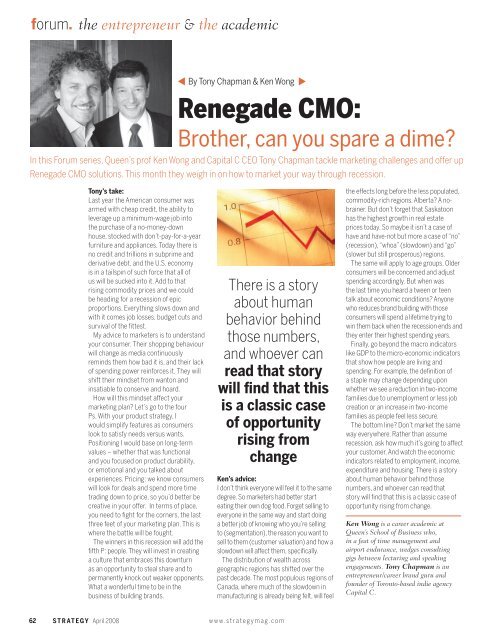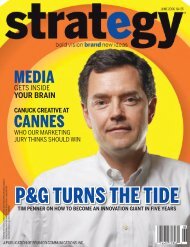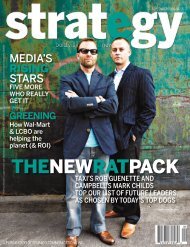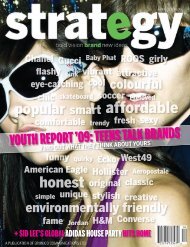Download PDF - Strategy
Download PDF - Strategy
Download PDF - Strategy
You also want an ePaper? Increase the reach of your titles
YUMPU automatically turns print PDFs into web optimized ePapers that Google loves.
��������the entrepreneur & the academic<br />
By Tony Chapman & Ken Wong<br />
Renegade CMO:<br />
Brother, can you spare a dime?<br />
In this Forum series, Queen’s prof Ken Wong and Capital C CEO Tony Chapman tackle marketing challenges and offer up<br />
Renegade CMO solutions. This month they weigh in on how to market your way through recession.<br />
62 STRATEGY April 2008<br />
Tony’s take:<br />
Last year the American consumer was<br />
armed with cheap credit, the ability to<br />
leverage up a minimum-wage job into<br />
the purchase of a no-money-down<br />
house, stocked with don’t-pay-for-a-year<br />
furniture and appliances. Today there is<br />
no credit and trillions in subprime and<br />
derivative debt, and the U.S. economy<br />
is in a tailspin of such force that all of<br />
us will be sucked into it. Add to that<br />
rising commodity prices and we could<br />
be heading for a recession of epic<br />
proportions. Everything slows down and<br />
with it comes job losses, budget cuts and<br />
survival of the fi ttest.<br />
My advice to marketers is to understand<br />
your consumer. Their shopping behaviour<br />
will change as media continuously<br />
reminds them how bad it is, and their lack<br />
of spending power reinforces it. They will<br />
shift their mindset from wanton and<br />
insatiable to conserve and hoard.<br />
How will this mindset affect your<br />
marketing plan? Let’s go to the four<br />
Ps. With your product strategy, I<br />
would simplify features as consumers<br />
look to satisfy needs versus wants.<br />
Positioning I would base on long-term<br />
values – whether that was functional<br />
and you focused on product durability,<br />
or emotional and you talked about<br />
experiences. Pricing: we know consumers<br />
will look for deals and spend more time<br />
trading down to price, so you’d better be<br />
creative in your offer. In terms of place,<br />
you need to fi ght for the corners, the last<br />
three feet of your marketing plan. This is<br />
where the battle will be fought.<br />
The winners in this recession will add the<br />
fi fth P: people. They will invest in creating<br />
a culture that embraces this downturn<br />
as an opportunity to steal share and to<br />
permanently knock out weaker opponents.<br />
What a wonderful time to be in the<br />
business of building brands.<br />
There is a story<br />
about human<br />
behavior behind<br />
those numbers,<br />
and whoever can<br />
read that story<br />
will fi nd that this<br />
is a classic case<br />
of opportunity<br />
rising from<br />
change<br />
Ken’s advice:<br />
I don’t think everyone will feel it to the same<br />
degree. So marketers had better start<br />
eating their own dog food. Forget selling to<br />
everyone in the same way and start doing<br />
a better job of knowing who you’re selling<br />
to (segmentation), the reason you want to<br />
sell to them (customer valuation) and how a<br />
slowdown will affect them, specifi cally.<br />
The distribution of wealth across<br />
geographic regions has shifted over the<br />
past decade. The most populous regions of<br />
Canada, where much of the slowdown in<br />
manufacturing is already being felt, will feel<br />
www.strategymag.com<br />
the effects long before the less populated,<br />
commodity-rich regions. Alberta? A nobrainer.<br />
But don’t forget that Saskatoon<br />
has the highest growth in real estate<br />
prices today. So maybe it isn’t a case of<br />
have and have-not but more a case of “no”<br />
(recession), “whoa” (slowdown) and “go”<br />
(slower but still prosperous) regions.<br />
The same will apply to age groups. Older<br />
consumers will be concerned and adjust<br />
spending accordingly. But when was<br />
the last time you heard a tween or teen<br />
talk about economic conditions? Anyone<br />
who reduces brand building with those<br />
consumers will spend a lifetime trying to<br />
win them back when the recession ends and<br />
they enter their highest spending years.<br />
Finally, go beyond the macro indicators<br />
like GDP to the micro-economic indicators<br />
that show how people are living and<br />
spending. For example, the defi nition of<br />
a staple may change depending upon<br />
whether we see a reduction in two-income<br />
families due to unemployment or less job<br />
creation or an increase in two-income<br />
families as people feel less secure.<br />
The bottom line? Don’t market the same<br />
way everywhere. Rather than assume<br />
recession, ask how much it’s going to affect<br />
your customer. And watch the economic<br />
indicators related to employment, income,<br />
expenditure and housing. There is a story<br />
about human behavior behind those<br />
numbers, and whoever can read that<br />
story will fi nd that this is a classic case of<br />
opportunity rising from change.<br />
Ken Wong is a career academic at<br />
Queen’s School of Business who,<br />
in a feat of time management and<br />
airport endurance, wedges consulting<br />
gigs between lecturing and speaking<br />
engagements. Tony Chapman is an<br />
entrepreneur/career brand guru and<br />
founder of Toronto-based indie agency<br />
Capital C.














